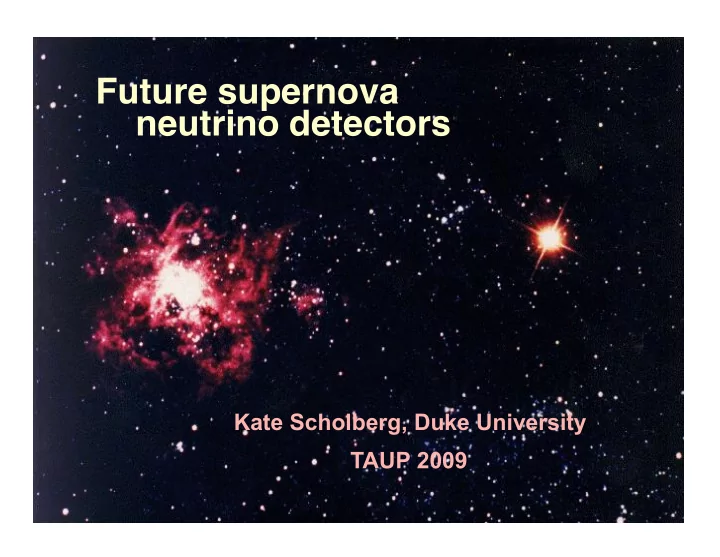

Future supernova neutrino detectors Kate Scholberg, Duke University TAUP 2009
OUTLINE Brief summary of current detectors Near and medium term detectors Farther future mega-detectors What GW coincidence can add
Current supernova neutrino detectors Detector Type Location Mass Events Status (kton) @ 8 kpc Super-K Water Japan 32 8000 Running (SK IV) LVD Scintillator Italy 1 300 Running KamLAND Scintillator Japan 1 300 Running Borexino Scintillator Italy 0.3 100 Running IceCube Long string South Pole 0.4/PMT N/A Running Baksan Scintillator Russia 0.33 50 Running Mini- Scintillator USA 0.7 200 Running BOONE Primary sensitivity is to electron antineutrinos via inverse beta decay ν e + p e + + n
Near term future experiments (~5 years) ICARUS: 600 ton LAr ν e + 40 Ar → e - + 40 K* E thr =1.5 MeV CC _ ν e + 40 Ar → e - + 40 Cl* E thr =7.48 MeV ν x + 40 Ar → ν x + 40 Ar* E thr =1.46 MeV NC ν e,x + e - → ν e,x + e - ES - Tag modes with gamma - spectrum (or lack thereof) - Excellent electron neutrino sensitivity
HALO at SNOLab Relative rates depend CC ν e + 208 Pb → 208 Bi* + e - on ν energy ⇒ spectral 1n, 2n emission sensitivity ν x + 208 Pb → 208 Pb* + ν x NC 1n, γ emission from T. Massicotte thesis SNO 3 He counters + 76 tons of Pb: ~85 events @ 10 kpc
NO ν A : long baseline oscillation experiment (Ash River, MN) 15 kton scintillator, near surface K. Arms, CIPANP ‘09
SNO+ : SNO vessel filled with scintillator ~300 inverse beta decay events @ 10 kpc
Current and near-future supernova neutrino detectors Detector Type Location Mass Events Status (kton) @ 8 kpc Super-K Water Japan 32 8000 Running (SK IV) LVD Scintillator Italy 1 300 Running KamLAND Scintillator Japan 1 300 Running Borexino Scintillator Italy 0.3 100 Running IceCube Long string South Pole 0.4/PMT N/A Running Baksan Scintillator Russia 0.33 50 Running Mini- Scintillator USA 0.7 200 Running BOONE HALO Lead Canada 0.076 85 Under construction Icarus Liquid argon Italy 0.6 230 Almost ready NO ν A Scintillator USA 15 3000 Construction started SNO+ Scintillator Canada 1 300 Funded
Farthest distance reach: Super-K Distant burst search:E > 17 MeV, ≥ 2 ev/20 s Low threshold burst search: E > ~ 7 MeV, ≥ 3 ev/0.5 s OR ≥ 4 ev/2 s OR ≥ 8 ev/10 s Ap. J, .669:519-524,2007, arXiv:0706.2283
Current best neutrino detectors sensitive out to ~ few 100 kpc.. mostly just the Milky Way 3 ± 1 per century
How requiring a GW coincidence with a single SK event affects SK sensitivity: SK single event (bg: 1 ev/day) current SK burst search (require double) Improves probability of detection of supernova in Andromeda from 8% to 30% (and one could optimize search parameters to possibly do better)
Looking beyond: number of sources α D 3 S. Ando et al., PRL 95:171101, 2005: singles{ doubles Mton SK With Mton scale detector, probability of detecting 1-2 events reasonably close to ~1 at distances where rate is <~1/year Tagging signal over background becomes the issue ⇒ require double ν 's or grav wave/optical coincidence
Next generation mega-detectors (10-20 years) 5-100 kton-scale LAr detector concepts DUSEL LBNE 100 kton-scale scintillator Hyper-K detector concepts LENA, HanoHano Memphys Megaton-scale water detector concepts
Zoom in on LBNE water Cherenkov detector Possible WC detector design: 100 kton modules Studies underway to optimize detector parameters e.g. PMT coverage, Gd solute (for SN, want low threshold)
Expected signal at 7 MeV threshold SN burst signal CR µ (unvetoed) other bg, scaled from SK Clean signal out to Andromeda @ 4290 mwe
Distance sensitivity for early alert (not physics) depends on: Mass Background rate λ λ (ignoring correlated background like spallation) E th ~ 5 MeV Δ T = 10 s Could provide early alert for SN in Andromeda assuming reasonable bg rejection
Sensitivity enhancement from external trigger Reach with GW coincidence 300 kt SK singles doubles 300 kt doubles
Individual experiments can use POINTING ASYMMETRIC REACTIONS (triangulation is hard) Elastic scattering off electrons is the best bet ν e,x + e - → ν e,x + e - In water Cherenkov few % of total rate ν e,x e - POINTING from Cherenkov cone: (slightly degraded by isotropic bg ) G. Raffelt SK: expect ~200 ES for 8.5 kpc SN DUSEL WC: (5-10 from breakout) <~ 1 o ⇒ ~ 4 o pointing pointing
Summary of supernova neutrino detectors Detector Type Location Mass Events Status y (kton) @ 8 kpc t i v Super-K Water Japan 32 8000 Running (SK IV) i t i LVD Scintillator Italy 1 300 Running s n KamLAND Scintillator Japan 1 300 Running e Borexino Scintillator Italy 0.3 100 Running s c IceCube Long string South Pole 0.4/PMT N/A Running i t Baksan Scintillator Russia 0.33 50 Running c a Mini- Scintillator USA 0.7 200 Running l a BOONE G HALO Lead Canada 0.076 85 Under construction Icarus Liquid argon Italy 0.6 230 Almost ready NO ν A Scintillator USA 15 3000 Construction started SNO+ Scintillator Canada 1 300 Funded DUSEL LAr Liquid argon USA 5 1900 Proposed Extragalactic DUSEL WC Water USA 300 78,000 Proposed MEMPHYS Water Europe 440 120,000 Proposed Hyper-K Water Japan 500 130,000 Proposed LENA Scintillator Europe 50 15,000 Proposed GLACIER Liquid argon Europe 100 38,000 Proposed
Summary Current and near future detectors have ~Galactic sensitivity; SK reaches barely to Andromeda Next generation of mega-detectors will have extragalactic sensitivity: rate of possible GW/ ν coincidences will be ~1/few year
Recommend
More recommend